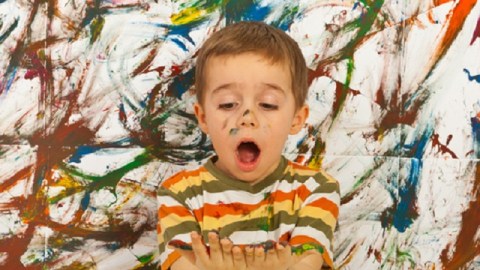Are American Children Starved for Art?

A recent report from Birmingham, England, announced that millions of British children were “culture starved.” Their proof of starvation came in the form of a survey of 2,000 parents from across the U.K. that found that 4 in 10 children from ages 5 through 12 had never been in an art gallery and that 17% had never been to a museum with their parents. Although another report refutes this alarmist report as a marketing ploy to get parents to take the kids to the museum before they “starve,” it did make me—both as someone interested in the arts and as a concerned parent—wonder if my kids are “culture starved” here in the United States and just how culturally nourished the average American child is?
Visit Birmingham, the source of the “culture starved” press release, should be chastised for crying cultural wolf, but it’s not the first time that an advertiser preyed on the fears of a parent, and it surely won’t be the last. If it does get families spending more time together in cultural institutions, then I call no harm, no foul. At the very least, by ringing the alarm they confirmed that there was an alarm to be rung—namely, that a consensus exists that culture is a good thing and that children can benefit from exposure to it.
Or at least that’s the consensus in the U.K. Here in the midst of the American culture wars, it’s hard to get a consensus on anything, especially what is art or history or even science, for that matter. I tried in vain to find recent and comprehensive statistics on the attendance of American art museums by children. (If anyone has better results or is involved in such research, please share in the comments.) According to the American Association of Museums’ FAQ page, in 2009 the median attendance for American art museums was 44,878, which trailed Science/Technology Center/Museum (357,103), Living Collections (208,574), Children’s/Youth Museum (130,870), General Museum (58,500), and Natural History/Anthropology Museum (58,176), but beat out Historic House/Site (11,700) and History Museum/Historical Society (10,000).
Judging from these numbers and my anecdotal parental experience, I’m guessing that the bells and whistles of science museums help push them to the top when you add parents and kids and push the usually quieter art and history institutions to the bottom. Another factor in the possible art and culture starvation of American children is the near death of the institution formerly known as the field trip. Hard statistics are hard to come by on how many or how few field trips still happen, but anecdotal evidence and the gutting of art programs in schools in the wake of No Child Left Behind make the prognosis look quite grim. Field trips to science museums still seem safe, thanks to the curricular choices of NCLB, but art and even history museums most likely are more kid free in the past as the arts and even social studies become relics of the educational past.
Perhaps someone needs to sound a similar alarm in America as Visit Birmingham did for England, however fleetingly and however falsely. The long litany of reasons why children need the arts has been rehearsed too many times for me to repeat here (but Eliot Eisner’s “10 Lessons the Arts Teach” from his The Arts and the Creation of Mind is a great place to start). When I think of my almost 6-year-old son walking around the Philadelphia Museum of Art, our local museum, and pointing out his favorite Picasso and remembering which room has a Sol LeWitt on the ceiling, and see the way his eyes light up, I can’t imagine what it’s like for a child never to have that moment of transcendence. Yes, starvation of the body is a far greater problem in our country and the world, but this kind of starvation of the soul strikes me as something even deeper in the long run. Even if this isn’t a problem (and I’m betting it is), filling up kids souls with beauty and imagination seems like something we can, and should, do everyday.
[Image source:Shutterstock.com. Copyright: Blaj Gabriel.]





